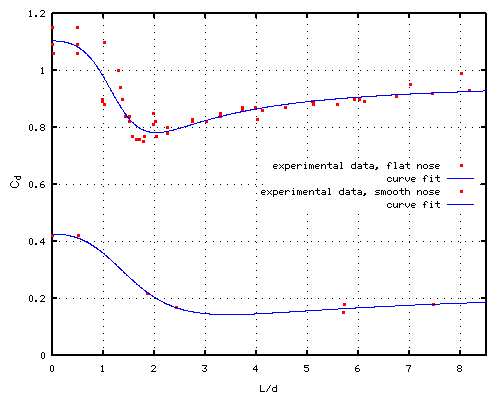Drag coefficient of Nerf darts
Posted by btrettel on May 31, 2013
The drag coefficient tells you how much drag affects an object moving in a fluid. A higher drag coefficient means that the drag force is larger, which’ll slow down an object more. Lower drag darts will have more range and travel faster.
What’s the drag coefficient of a Nerf dart? Many tests have been done on cylinders. I’ve plotted the results of these tests below. The data comes from this paper and this book.

This is a plot as a function of fineness ratio ( ), which is the ratio of the dart’s length to its diameter. This’ll allow the results to scale up for any size dart.
), which is the ratio of the dart’s length to its diameter. This’ll allow the results to scale up for any size dart.
Nerf darts seem to be much closer to the flat nose curve above than the smooth nose one. Tests done by Daniel Beaver have shown that Nerf darts with a length of 1.25 inches have a drag coefficient of about 0.67.
This plot shows that darts have the least drag in the range of  = 1.75 to 3. The increase in drag for darts shorter than that is much steeper than the increase for longer darts. The variability also increases for shorter darts, which could reduce accuracy. Based on this information, we should make our darts about 2.5 times as long as their diameter to have low drag and good accuracy.
= 1.75 to 3. The increase in drag for darts shorter than that is much steeper than the increase for longer darts. The variability also increases for shorter darts, which could reduce accuracy. Based on this information, we should make our darts about 2.5 times as long as their diameter to have low drag and good accuracy.
The curve fits I developed above use this equation:

For the flat nose,  = 1.104,
= 1.104,  = -0.988,
= -0.988,  = 0.402, and
= 0.402, and  = 0.413. For the smooth nose,
= 0.413. For the smooth nose,  = 0.427,
= 0.427,  = -0.579,
= -0.579,  = 0.060, and
= 0.060, and  = 0.248.
= 0.248.  is the drag coefficient of a cylinder with effectively zero length.
is the drag coefficient of a cylinder with effectively zero length.
Typical darts were longer at one time. Perhaps Nerfers have slowly have figured out that shorter darts perform better. In 2004, the average Nerf dart was 2.1 inches long ( = 4.0). In 2008, the average dart was 1.7 inches long (
= 4.0). In 2008, the average dart was 1.7 inches long ( = 3.2). Now I’d say darts are even shorter. Daniel Beaver’s tests used darts with a fineness ratio of 2.4, which is about what I suggest based on this data.
= 3.2). Now I’d say darts are even shorter. Daniel Beaver’s tests used darts with a fineness ratio of 2.4, which is about what I suggest based on this data.
7 Responses to “Drag coefficient of Nerf darts”
Sorry, the comment form is closed at this time.
John said
Nerf darts are also drag stabilized, so there must be some sort of ratio that also optimizes accuracy and distance, I would think?
btrettel said
Accuracy and distance are two different things, so if there’s a ratio that optimizes both accuracy and distance, that’d be very convenient.
But you are right; there probably is a ratio that optimizes accuracy. I’m not sure what this ratio is. Simple theoretical work I’ve done suggests that any dart length that puts the center of gravity ahead of the center of pressure is good, but reality says it’s more complicated than that. I’ve read a fair amount about flow induced vibrations to help understand this, and unfortunately it does not appear that the experimental data we need to figure out dart stability (i.e., whether or not it’ll fishtail) exists.
ratio that optimizes accuracy. I’m not sure what this ratio is. Simple theoretical work I’ve done suggests that any dart length that puts the center of gravity ahead of the center of pressure is good, but reality says it’s more complicated than that. I’ve read a fair amount about flow induced vibrations to help understand this, and unfortunately it does not appear that the experimental data we need to figure out dart stability (i.e., whether or not it’ll fishtail) exists.
Jack said
So I’m doing a physics experiment and using three different darts, they are about 7.5cm (2.9in) what will be the drag coefficient for them?
btrettel said
I’ll need more information. The plot needs both length and diameter. Once you know the length-to-diameter ratio (L/d) then you can look it up on the plot.
Jack said
The length is 7.5cm and the diameter is about 1cm
btrettel said
Then the L/d ratio is easy because 7.5 divided by 1 is 7.5. Look at the plot above for the cylinder case and you’ll see the drag coefficient should be about 0.9 if the dart were a perfect cylinder. Nerf darts aren’t, but 0.9 should still be a good estimate.
Jack said
Thank you 🙂